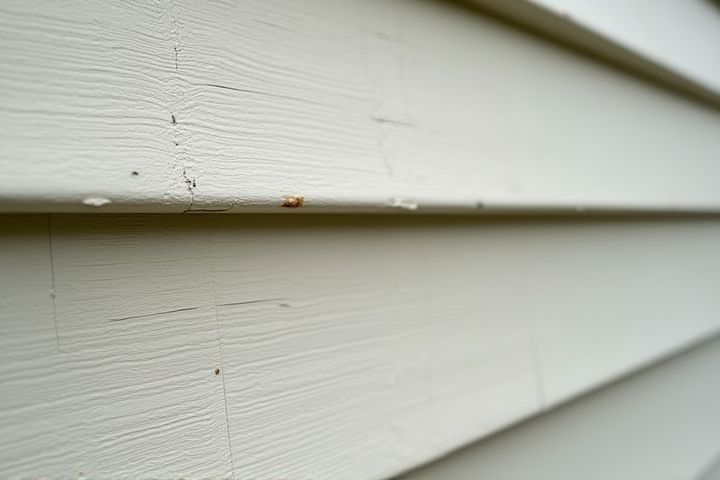
House siding can warp due to several factors, including moisture exposure, temperature fluctuations, and poor installation techniques. When water seeps into siding materials, such as wood or fiber cement, it can expand and eventually lead to bending or curling. Extreme heat can also cause some siding types, particularly vinyl, to warp as they soften under high temperatures. Inadequate ventilation can trap heat and humidity, further exacerbating the warping process. Maintaining proper sealing and ensuring professional installation can help mitigate these issues and prolong the life of your siding.
Why Does House Siding Warp
Excessive heat exposure
Excessive heat exposure can lead to significant warping of house siding, particularly in materials like vinyl and wood. When temperatures rise above 100degF, vinyl siding can become pliable, causing it to stretch and twist out of shape. Similarly, wood siding may absorb heat, leading to drying, shrinking, and ultimately distortion. Regular maintenance, such as ensuring adequate shade or applying heat-resistant finishes, can help mitigate these effects and prolong the lifespan of your siding.
Poor installation
Poor installation of house siding can lead to warping due to improper alignment and fastening techniques. When siding panels are not secured correctly, they may expand and contract with temperature fluctuations, resulting in unsightly bends and distortions. Additionally, inadequate sealing around edges can allow moisture infiltration, further compromising the siding structure and integrity. Ensuring precise installation techniques, including the use of appropriate materials and tools, is essential in preventing these issues and maintaining the aesthetic appeal of your home.
Low-quality materials
Low-quality materials used in house siding can lead to warping due to their inability to withstand environmental stressors. For instance, vinyl siding made from inferior plastic may expand or contract significantly with temperature fluctuations, resulting in deformation. Similarly, poorly manufactured wood siding is susceptible to moisture absorption, which can cause swelling and eventual warping. Investing in high-quality siding materials can effectively mitigate these issues, ensuring a more durable and stable exterior for your home.
Moisture infiltration
Moisture infiltration is a primary cause of house siding warping, leading to significant structural damage over time. When water seeps behind the siding, it can penetrate the material, causing it to swell and lose its shape; this is particularly evident in wood and vinyl siding. Studies indicate that approximately 20% of siding failures are directly linked to moisture issues, highlighting the importance of proper installation and preventive measures. Maintaining a moisture-resistant barrier, regular inspections, and timely repairs can greatly reduce the risk of warping and prolong the lifespan of your siding.
Thermal expansion and contraction
House siding can warp primarily due to thermal expansion and contraction, processes influenced by temperature fluctuations. For instance, materials such as vinyl or wood can expand when exposed to high temperatures, increasing their dimensions and leading to strain. Conversely, as temperatures drop, these materials contract, potentially causing stress points and misalignment. Over time, this cycle of expansion and contraction can lead to noticeable warping, affecting the integrity and aesthetics of your home's exterior.
Improper maintenance
Improper maintenance is a leading cause of house siding warping, as neglecting regular inspections can allow moisture to infiltrate and damage the material. For example, failing to clean gutters every six months can lead to water pooling, which may cause wood siding to swell and warp. Moreover, paint or sealant that is not reapplied every 3-5 years can deteriorate, exposing siding to the elements and resulting in structural issues. To prevent warping, consistently check for signs of wear and ensure timely repairs to maintain the integrity of your siding.
Direct UV damage
Direct UV damage is a significant factor contributing to the warping of house siding. Prolonged exposure to ultraviolet rays can cause materials, particularly vinyl and wood, to degrade and lose their structural integrity, resulting in warping or buckling. Research indicates that unprotected siding can experience surface temperatures exceeding 140degF on sunny days, accelerating this deterioration process. By applying protective coatings or opting for materials engineered to resist UV damage, you can significantly extend the lifespan of your siding and maintain its aesthetic appeal.
Inadequate ventilation
Inadequate ventilation can lead to significant warping of house siding, as it traps moisture within the walls. This moisture accumulation creates an ideal environment for rot and mold, further exacerbating the warping process. Homes with insufficient airflow often experience temperature fluctuations that contribute to the expansion and contraction of siding materials, resulting in distortion. Maintaining proper ventilation through vents and airflow pathways can help prevent these issues, ensuring the longevity and aesthetic integrity of your home's exterior.
Substandard substrate
House siding often warps due to a substandard substrate, which can include improperly installed plywood or OSB (oriented strand board). These materials may absorb moisture, leading to swelling and subsequent warping of the siding. With an estimated 30% of siding failures attributed to inadequate substrates, it's crucial to use high-quality, moisture-resistant materials when installing. Proper venting and sealing techniques can mitigate these issues, ensuring your siding remains stable and visually appealing over time.
Chemical reactions with cleaning agents
House siding can warp due to chemical reactions between certain cleaning agents and the materials used in siding, such as vinyl or wood. For instance, harsh chemicals like bleach can weaken siding's structural integrity, making it susceptible to warping and discoloration over time. High pH cleaners, when applied incorrectly, may also react adversely, causing surfaces to degrade and bend, which can compromise insulation and increase energy costs. To maintain the longevity of your siding, opt for gentle, siding-specific cleaners that are formulated to avoid such harmful chemical interactions.
